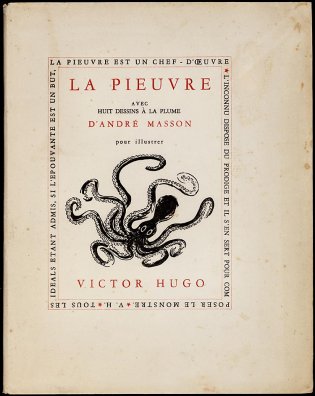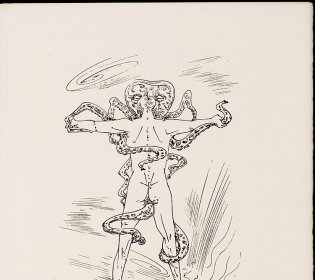La pieuvre
Year: 1944
Author: Victor Hugo (1802 - 1885)
Artist: André Masson (1896 - 1987)
Publisher: Éditions des Lettres françaises
The editor: Roger Caillois
Like Masson, writer Roger Caillois (1913-1978) would not spend the war in France. He was invited to move to Buenos Aires (Argentina) by Victoria Ocampo in 1939. She was wealthy, had a passion for literature, and headed Sur, the Argentinian version of La nouvelle revue Française (NRF). Ocampo helped Caillois found the famous magazine Lettres françaises in 1941, which should not be confused with the eponymous clandestine magazine founded by Jean Paulhan in France under the Vichy regime. Buenos Aires proved to be a favourable environment for a French magazine about literature, art and politics, because it contained a large French-speaking community.
Éditions des Lettres françaises
In 1942, Caillois produced a remarkable edition via his magazine: this was the collection of poetry Exil by Saint-John Perse, who was admired greatly by Caillois. The Éditions des Lettres françaises only published two artist's books through the intervention of publisher Roger Caillois: Fata Morgana (1942) by André Breton, and La pieuvre by Victor Hugo in 1944.
Bibliographical description
Description: La pieuvre / [Victor Hugo] ; avec 8 dess. à la plume d'André Masson pour ill. Victor Hugo ; [publ. par les soins de Roger Caillois]. – Buenos Aires, Éditions des Lettres françaises, 1944. - 39 p. : ill. ; 29 cm
Printer: Francisco A. Colombo (Buenos Aires)
Edition: 345 copies
This copy: Number XVII of 10 (numbered XI-XX) on Coat Skin
Bibliography: Bénézit 9-331 ; Monod 6174 ; Skira 250
Shelfmark: KW Koopm K 38
References
- Jean-Paul Clébert, 'André Masson', in: Dictionnaire du Surréalisme, Paris, Seuil, 1996, p. 362-373
- Odile Felgine, Roger Caillois: Biographie.Paris, Stock, 1994
- Victor Hugo, Notre-Dame de Paris, 1482, Les Travailleurs de la mer. Paris, Gallimard, 1975
- Michel Leiris, André Masson et son univers. Genève, Éditions des Trois Collines, 1947





